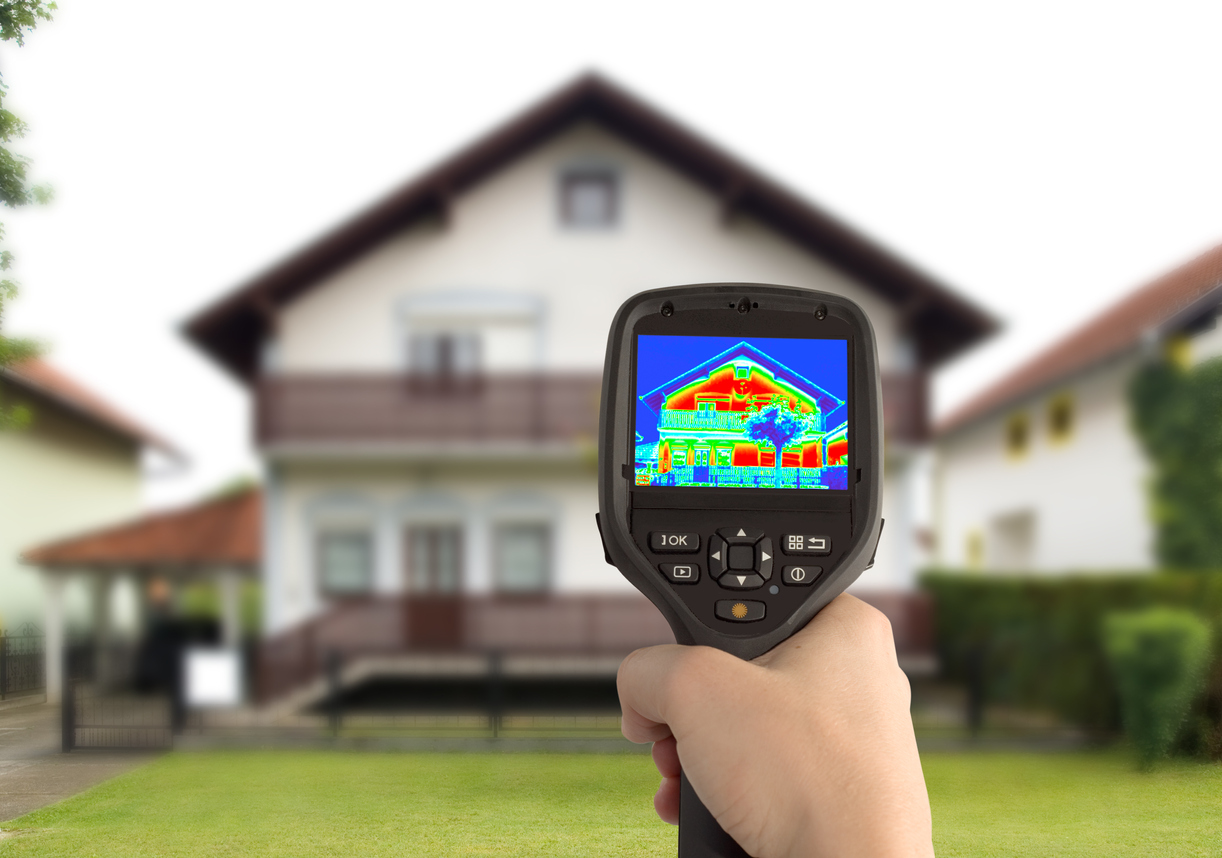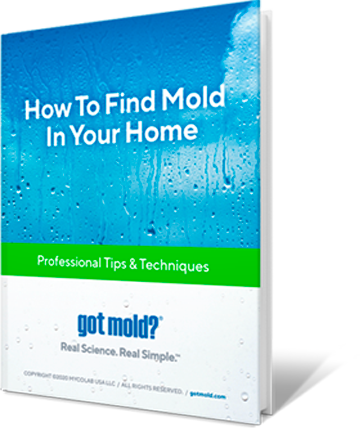
Can you measure indoor humidity levels and find water leaks on your own, or do you need a professional to do the job?
There’s no need to guess when it comes to how much moisture is in your home. You can use tools to monitor your indoor humidity levels and find water leaks—and you can easily find them at local hardware stores or online.
How Humidity is Measured: Relative Humidity vs. Absolute Humidity
Before we get into tools that measure humidity and moisture in your home, let’s take a moment to talk about the different ways humidity is measured.
Relative Humidity
Relative Humidity (RH) is the amount of water vapor present in the air relative to the amount it could hold at that given temperature.
When air gets warmer, it expands and can hold more water vapor.
When air gets colder, it contracts and can hold less water vapor.
Let’s do a little science experiment in our minds to picture this better:
Imagine a 12-ounce cup filled with six ounces of water. This is our control cup. It’s 50% full of water.
Now imagine it’s a hot day. As the day gets warmer, that cup expands and gets bigger. You now have a cup that can hold 24 ounces of water. This bigger cup is still filled with six ounces of water, but now it’s only 25% full.
On the flip side, imagine it’s a cold day. The colder it is, the smaller your cup gets. Let’s say your cup has shrunk down to a six-ounce capacity. Since your six-ounce cup is filled with six ounces of water, it’s now 100% full.
All three cups held the same amount of water. But the measurement of water changed relative to how much each cup could hold.
This is how relative humidity is measured. It’s the amount of water vapor the air can hold at any given temperature, and the result is expressed as a percentage.
Absolute Humidity (AH):
Absolute humidity is the actual amount of water vapor present in the air, regardless of the temperature.
Absolute humidity compares the mass of water vapor to the mass of dry air, and it’s expressed as a ratio in grams of moisture per cubic meter of air (g/m3).
Usually, when we’re talking about ideal humidity levels (between 40% and 60%), we’re talking about measuring and monitoring relative humidity (RH) levels. You can learn more about humidity — and the problems it can cause — at our Complete Guide to Humidity and Moisture in the Home!
Now, on to the tools!
4 Tools to Measure Humidity and Moisture in Your Home
Hygrometers
A hygrometer is a tool used to measure the amount of water vapor (humidity) in the air. Remember when we talked about temperature affecting humidity levels above? Your hygrometer will typically measure the relative humidity (RH) of your air and show you the temperature as well as its correlating humidity percentage.
Hygrometers have come a long way from their first iterations when designers used oak husks or human hair to measure humidity! Today’s humidity measuring tools use semiconductive materials or mercury thermometers to precisely measure relative humidity.
Modern hygrometers will usually have a nice, big easy-to-read digital display, and most connect to Wi-Fi or Bluetooth allowing for text or email alerts when your temperature and moisture levels exceed pre-set limits. What’s more, many digital hygrometers feature smartphone apps that will allow you to monitor humidity levels on the go.
So what should your ideal indoor humidity levels be? The American Society of Heating, Refrigerating and Air-Conditioning Engineers (ASHRAE) recommends a target level of 45% RH, but hitting that exactly on the nose can be difficult. It’s easier to set an ideal range of 40-60% humidity.
Look for a hygrometer that allows for multiple wireless sensors so you can monitor humidity levels of various locations throughout your home. This is especially useful since most moisture and mold problems occur in your home’s “out of sight, out of mind” places, such as attics, basements, crawl spaces, and other tucked-away places that you might not often frequent.
Moisture Meters
Moisture meters are valuable tools to help you detect moisture in building materials such as wood or wallboard. If your home has a water leak in an out-of-sight location, such as behind a wall or ceiling, a moisture meter can help you find it even if you can’t see it.
There are two types of moisture meters: pin-type moisture meters and pinless moisture meters.
Pin-type moisture meters use two electrodes to scan for moisture by inserting the probes into drywall, or whatever material you’re concerned about (even though they are generally designed and calibrated to measure moisture in wood). Since the device looks for moisture readings between the electrodes, it can only scan small, more precise areas. Pin-type meters are typically used in standard home inspections. Keep in mind that they leave small holes where you probe, so be ready with your spackle if it’s in a visible area. These tend to be the least expensive type, and also the most user-friendly.
Pinless moisture meters scan larger areas and make finding moisture readings and leaks a lot quicker. Pinless meters use electromagnetic waves (like radio waves or an electrical current) that are affected by moisture. They can be more difficult to read because different materials have different densities and varying conductive properties. This type of moisture meter is most often used by moisture professionals and can get fairly expensive.
The key to using a moisture meter, be it pin-type or pinless, is to take things slow. Be prepared for false or inconclusive readings, and always be on the lookout for the source of the moisture. After all, while wet materials are a problem, the bigger issue is how they got wet in the first place.
Water Sensors
Time is of the essence when you have a water leak at home. Often, the damage is done long before you see a visible sign of the leak.
Place a water sensor in leak-prone areas of your home, such as near:
- Sinks
- Toilets
- Fish tanks
- Sump pits
- Dishwasher
- Hot-water heaters
- Washing machines
- Furnaces and boilers
- Refrigerators with ice makers and water dispensers
Some water sensors are Wi-Fi enabled so you can get instantly alerted to a water leak in your home. Others may be configured to shut off the water in the house to prevent a small leak from becoming a big problem.
We recommend: Sensative Strips Drip with 10 years of battery life.
Infrared Cameras
One tool that is now much more accessible for consumers to use at home is infrared cameras.
While infrared cameras don’t really “see” through your walls, they are nevertheless really good at measuring surface temperatures. What does this have to do with water leaks? A wet spot will register colder than its dryer surrounding areas because of evaporation. These cameras used to be $50-60k a pop, but tech advances now allow you can get a good one for just a few hundred dollars.
They can be highly useful for finding leaks, wet or missing insulation, leaky ducts, issues in the ceiling, and more.
The key to using infrared cameras effectively is to consider them a screening tool. Once an infrared camera has identified a problem area, go on to utilize moisture meters and other tools to collect more data.
Conclusion
Used properly, tools that help you detect water leaks and monitor/measure your indoor humidity levels can effectively and efficiently determine moisture problems in your home. Excessive moisture can lead to mold growth, structural damage, an increase in pests, and more symptoms that can be harmful to the building and the health of occupants.
Fortunately, these tools are more accessible and user-friendly than ever, and they can help you take back control of your home’s health and safety.

